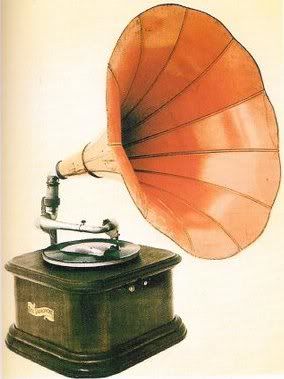On the left, is Lodovico Sforza, Il Moro (the Moor, a nickname supposedly given to him because he tanned easily) duke of Milan, and on the right, Lorenzo di Medici, Il Magnifico ('nuff said).
And the reason we're here, the young man with the rather splendid legs and the two young pageboys carrying the package in the damask behind him, is none other than Signor Leonardo da Vinci. The content of the package, which will be revealed in a few moments is a magnificent silver lyre in the shape of a horse's head crafted by Leonardo himself.
The lyre is an excellent idea for a gift, suggesting that Lodovico will appreciate the classical associations of the instrument of Apollo and Orpheus, as well as being capable of playing the instrument himself. The fact that it is made from silver should give it a characteristically sweet tone, as well as representing more lucre in the ducal vaults!
Since I couldn't find a picture of Leonardo's presentation this detail from the mural of the court of the duke of Mantua should give a fair idea not only of the fashions, but the kind of characters that hang out with the duke.
As a matter of course, it is expected of any young man who moves in aristocratic circles that he should be a skilled horseman, poet, philosopher, soldier, and musician, and once the lyre has been unwrapped and offered to Lodovico, etiquette demands that Lodovico invite Leonardo to demonstrate the gift.
After the first few bars the murmur of chatter fades away. I think the thirty-year-old craftsman painter has made an impression, and no wonder! The piece he has chosen to demonstrate the lyre is quite a challenging song by the Flemish composer Johannes Ockeghem.
The musical riddles which Ockeghem poses in some of his compositions will keep scholars hard at work for many centuries to come, and no doubt the gentlemen of the court who pride themselves on their mathematical and scientific knowledge will find matter for debate in this piece for months to come.
the abc notation for the music below is available online.
For his part, Leonardo left a sodomy charge behind in Florence, and although he was acquitted, I wouldn't mind betting he has more admirers in the ducal court here in Milan than just Lodovico! But it ill-behooves me to speculate on Leonardo's private life. Let me present for you Jan Ockeghem's music:


 The written content of this work is licensed under a Creative Commons Attribution-Noncommercial-Share Alike 3.0 Unported License.
The written content of this work is licensed under a Creative Commons Attribution-Noncommercial-Share Alike 3.0 Unported License. 





